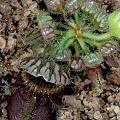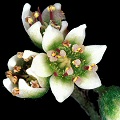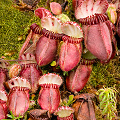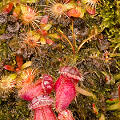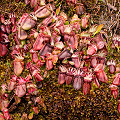Q: Cephalotus: cultivation
A: I won't lie to you. Cephalotus cultivation
is irritating. The plants may limp along in cultivation, and then suddenly die for no obvious reason.
Or the plants may do really well for a few years, then enter a long stage of the doldrums. Occasionally the plant
becomes almost entirely dormant---but then after a few to several months, new growth will appear....and then it may not
do a whole lot other than taunt you with tiny pitchers.
Meanwhile, a grower down the street will have fabulous plants growing like mad, with enormous pitchers.
I swear, in 2006 I was the judge at a carnivorous plant show and I
saw a Cephalotus plant on display with pitchers so huge I thought they were fake. Afterwards
I went home, looked at my own plants, and showered them with curses born of puny frustration.
<Rant>So what do you want me to do? Pretend I am an expert and give you a perfect prescription? I
have read those
prescriptions, and tried most of them. None have done the trick yet. Oh, you might think that you can grow these
plants because you have a pot of reasonable
looking plants, but until you have a pot as big as a milk jug, topped with a jungle of pitchers all longer than your thumb, and
with leaves pouring out of the drainage holes; until then, you ain't no expert. Damn you, Geoff Wong, how do you
do it???</Rant>
Rant aside, I will provide you with the conventional wisdom. Many growers use live Sphagnum in moist
conditions. Others use well drained
mixes, such as 4:1 perlite:Sphagnum. Or 3:2:1:1 mix of perlite:peat:sand:orchid bark.
Or a 3:2 mix of perlite:peat. Or 2:1 sand:peat. Or 2:1 peat:perlite. Notice the wide range in all these
prescriptions? Each one of those mixes has been told to me by experts as
the mix to use.
Keep temperatures somewhere in the broad range of 0-40°C (32-104°F).
If your plant appears to die back, hold off on the water a bit and wait. A few months later you might see regrowth.
Driven to frustration, some growers have taken to adding salt to their plants.
There is no evidence this does any good, but that doesn't stop people from trying it.
Propagation is best done by leaf cuttings. Snip the leaf from the rhizome, cutting as close to the rhizome as you dare.
Both pitcher leaves and foliage leaves work. Some people use leaf pullings, but a few times I did this a bit of rhizome came off
with the leaf pulling, and I became afraid that damage to the rhizome might allow the entry of pathogens. Root the cuttings in the
standard method---bury the cut end in moist Sphagnum and keep the cutting warm and in bright light.
Flowers usually do not produce seed when selfed. (Although I have gotten the occasional report from growers
that their plants have produced viable seed from selfings.) Some growers have multiple clones and are apparently having
success with seed production. Seeds germinate readily with no special treatment.
Fertilize by dropping bugs into the pitchers. A pinch of bloodworms or a few ants now and then seems to work well.
Page citations: Rice, B.A. 2006a; Tran, D. 2001; personal observations.
